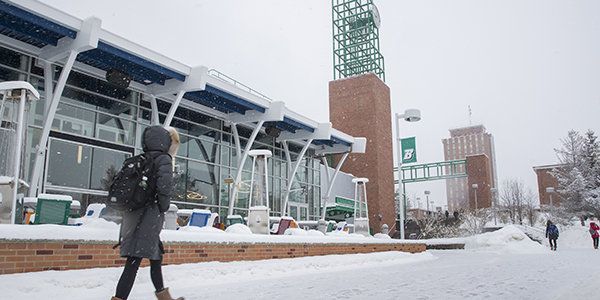Braving the cold: Keep yourself safe and warm this winter
Braving the cold: Keep yourself safe and warm this winter

Winter has made its inevitable return to Binghamton, and now we’re in the heart of it. With storms that dump a foot of snow overnight, below-freezing temperatures and difficult driving conditions, staying safe and warm during the long haul that is winter can be challenging. However, with some helpful tips you can properly prepare yourself to brave the cold weather still to come.
“Winter weather is potentially dangerous and capable of presenting serious safety risks,” said Dave Hubeny, executive director of Emergency Management at Binghamton University. “It is in everyone’s best interest to consider the potential risks of winter weather and take basic precautions to help minimize those risks.”
Staying informed about the daily weather is a great starting point, and with so many resources available, such as TV, radio, the internet and mobile apps, being informed is easier than ever.
“Find the source that fits your schedule and lifestyle and use it,” said Hubeny. “Many sources allow you to set up automated alerts that will warn you when dangerous weather is approaching, ensuring you will always be informed of potential weather hazards.”
Frostbite can result in loss of feeling or color of the face, fingers and toes. You may also experience numbness, pale or gray-yellowish skin, or firm, waxy skin. To treat frostbite, seek a warm room indoors and soak in warm water. Do not massage or use heating pads to warm up.
Hypothermia occurs when your body temperature falls below 95 degrees fahrenheit, and it can become a medical emergency. “Hypothermia can occur even during relatively warm weather,” said Michael Bender, public health program coordinator at the Broome County Health Department. “Being wet also greatly increases your chance of hypothermia.”
Signs of hypothermia include shivering, exhaustion, confusion, fumbling hands, memory loss, slurred speech or drowsiness. If you or someone else becomes hypothermic, get to a warm location immediately. Warm the center of the body first − head, neck, chest and groin − before extremities. Keep dry and remain wrapped in warm blankets until body temperature rises to normal levels.
Cold-weather tips for your home
Primary concerns for the home include a loss of heat, electricity and potentially food if a storm keeps you stuck indoors for a prolonged period. Keep the following on hand:
- Flashlights and extra batteries.
- A battery-powered cell phone charger.
- Extra food and water. Stock up on high-caloric foods such as nuts, trail mix, dried fruit and granola bars, as well as foods that don’t require cooking.
- First aid kit and any necessary medications.
- Extra blankets.
- Battery-powered NOAA Weather Radio or portable radio to hear weather updates.
Winter driving tips and vehicle safety
Driving in the winter can be treacherous. Be aware that everything takes longer on snow-covered roads, from accelerating to driving to turning and stopping. Go slow and start braking well before you need to stop. Braking with the ball of your foot and applying a firm, steady pressure to the pedal is the best way to stop without skidding. Additional driving tips include maintaining a following distance of eight to 10 seconds to allow extra reaction time and not coming to a complete stop while ascending hills to avoid getting stuck on icy or snow-covered roads.
In fact, when roadways are covered, you shouldn’t stop your car if you can avoid it. According to the American Automobile Association (AAA), “There’s a big difference in the amount of inertia it takes to start moving from a full stop versus how much it takes to get moving while still rolling. If you can slow down enough to keep rolling until a traffic light changes, do it.”
“Whenever possible, avoid traveling alone,” said Hubeny. “Always let someone know your travel plans, including your timetable and primary and alternate routes.”
Staying off the roads is always the safest option. Unless it’s absolutely necessary, remain indoors until roads are cleared and the weather passes. You may be confident in your winter-weather driving abilities, but other people may not drive as well. If you must go out, use caution and allot plenty of time to reach your destination.
Looking for more information? Check out some of these additional resources:
https://www.cdc.gov/disasters/winter/index.html
https://www.binghamton.edu/emergency/emergency-procedures/cold-safety.html
https://exchange.aaa.com/safety/driving-advice/winter-driving-tips/#.XEi8jM9Kh-V
